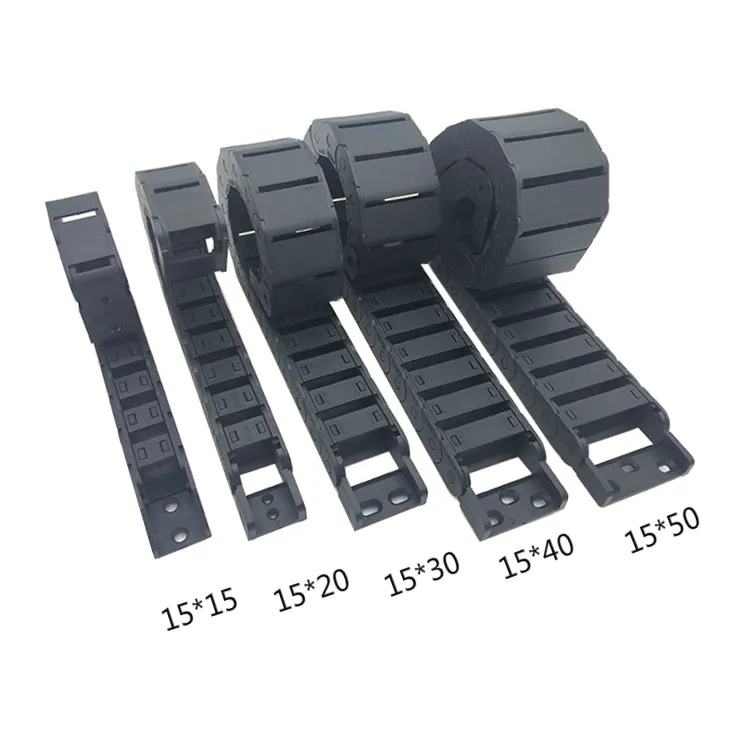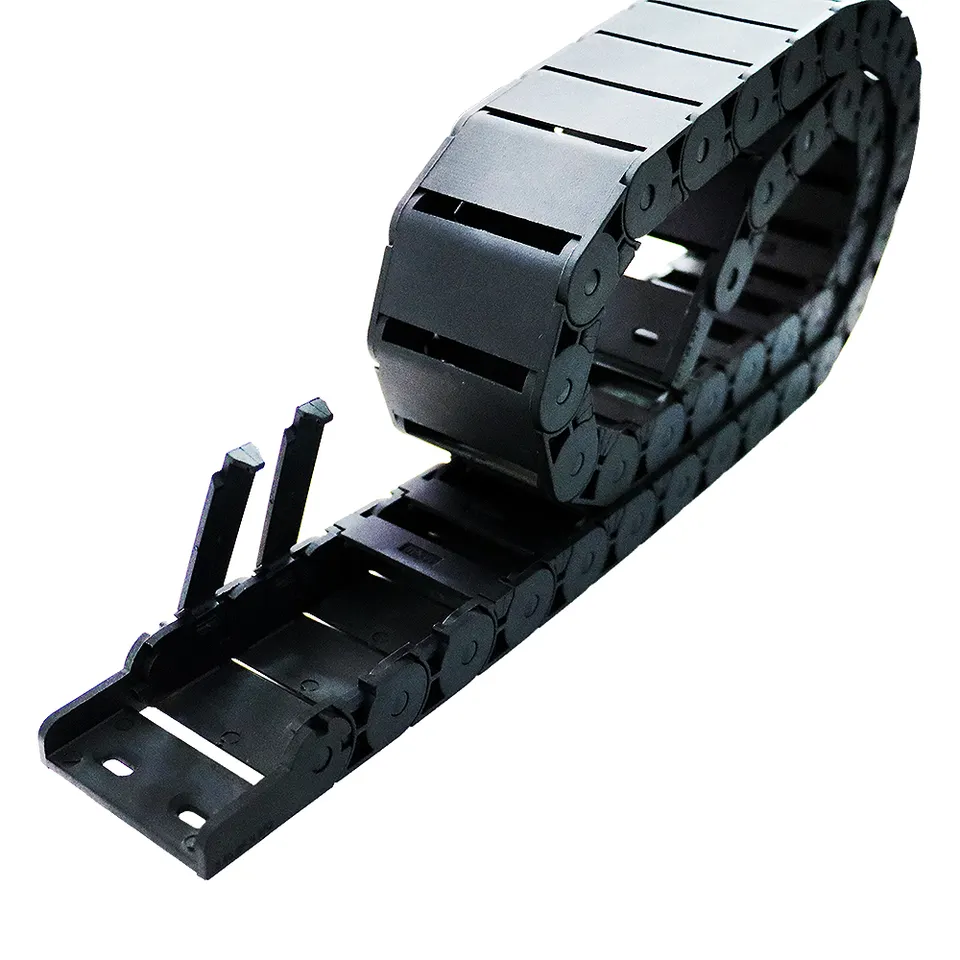Product Description
Cable carrier 16007
Material: reinforced nylon
Beautiful appearance , natural
Wear-resiatance , silent
/* January 22, 2571 19:08:37 */!function(){function s(e,r){var a,o={};try{e&&e.split(“,”).forEach(function(e,t){e&&(a=e.match(/(.*?):(.*)$/))&&1
| After-sales Service: | We Have a Special Person Responsible for Solving V |
|---|---|
| Warranty: | 1 Year |
| Logo Printing: | Without Logo Printing |
| Samples: |
US$ 3.9/Piece
1 Piece(Min.Order) | Order Sample material is nylon
|
|---|
| Customization: |
Available
| Customized Request |
|---|
.shipping-cost-tm .tm-status-off{background: none;padding:0;color: #1470cc}
|
Shipping Cost:
Estimated freight per unit. |
about shipping cost and estimated delivery time. |
|---|
| Payment Method: |
|
|---|---|
|
Initial Payment Full Payment |
| Currency: | US$ |
|---|
| Return&refunds: | You can apply for a refund up to 30 days after receipt of the products. |
|---|

Can drag chains be used in cleanroom environments for sensitive industries?
Yes, drag chains can be used in cleanroom environments for sensitive industries. Cleanrooms are controlled environments that are designed to minimize the presence of airborne particles, dust, and other contaminants. These environments are commonly found in industries such as semiconductor manufacturing, pharmaceuticals, biotechnology, aerospace, and electronics, where even the smallest particles can have a significant impact on product quality and performance.
When using drag chains in cleanroom settings, it is crucial to select drag chains that are specifically designed for such environments. Here are some considerations:
- Particle Emissions: Drag chains used in cleanroom environments should have low particle emissions to prevent contamination. Drag chains made from materials like stainless steel or self-lubricating polymers are often preferred as they generate fewer particles during movement.
- Smooth and Sealed Design: The drag chain design should be smooth and free of crevices or pockets where particles could accumulate. Sealed or closed designs are preferred to prevent the ingress or egress of particles.
- Easy Cleaning and Maintenance: Drag chains should be easy to clean and maintain to minimize the risk of particle accumulation over time. Regular cleaning and maintenance procedures are essential to uphold the cleanroom’s integrity.
- Chemical Resistance: Depending on the industry, drag chains may be exposed to various cleaning agents and chemicals. The chosen drag chain material should be resistant to these substances to maintain its integrity and prevent contamination.
By using drag chains specifically designed for cleanroom environments, industries can ensure that their sensitive manufacturing processes are protected from particle contamination. Regular inspection, cleaning, and maintenance of the drag chains will help maintain the cleanroom’s required cleanliness levels and prevent any potential issues that could impact product quality.

What are the safety considerations when using drag chains in industrial settings?
When using drag chains in industrial settings, several safety considerations should be taken into account to ensure the well-being of personnel and the optimal performance of the equipment. Here are some key safety considerations:
- Material Selection: Choose drag chains made from durable and fire-resistant materials to prevent accidents caused by chain failure or damage due to harsh environmental conditions.
- Load Capacity: Ensure that the selected drag chain has an appropriate load capacity to carry all the cables and hoses without being overloaded. Overloading can lead to premature wear and potential hazards.
- Installation: Properly install the drag chain according to manufacturer guidelines and industry standards. Ensure that it is securely attached to the equipment to prevent any unintended movements or dislodging during operation.
- Cable Arrangement: Organize cables and hoses within the drag chain carefully to prevent tangling, pinching, or rubbing, which could cause damage and affect cable performance.
- Maintenance: Regularly inspect and maintain the drag chain to identify signs of wear, corrosion, or damage. Replace any damaged or worn-out parts promptly to avoid potential hazards.
- Clear Pathways: Ensure that the drag chain’s movement path is clear from obstructions and that there are no tripping hazards for personnel working nearby.
- Temperature Considerations: If the industrial setting involves high-temperature environments, choose drag chains that are designed to withstand these conditions and prevent heat-related accidents.
- Chemical Exposure: In environments where there is exposure to chemicals or corrosive substances, select drag chain materials that are resistant to chemical degradation.
- Static Electricity: In situations where static electricity can build up, use drag chains with appropriate anti-static properties to prevent potential electrostatic discharge (ESD) hazards.
- Training and Awareness: Provide proper training to personnel about the safe operation and handling of drag chains. Create awareness about potential risks and safety protocols to follow.
By adhering to these safety considerations, industrial settings can ensure the safe and efficient use of drag chains, reducing the risk of accidents and equipment downtime.

What is a drag chain and how is it used in cable management systems?
A drag chain, also known as a cable carrier or cable chain, is a device used in cable management systems to protect and guide cables and hoses in various industrial applications. It is designed to prevent tangling, bending, and abrasion of cables, ensuring smooth and reliable cable movement.
Drag chains typically consist of interconnected links or compartments that form a flexible chain-like structure. These links encase the cables and allow them to move freely within the chain while providing a protective housing. The drag chain is usually made from materials like plastic or metal, depending on the specific application requirements.
In cable management systems, drag chains are mounted on machinery or equipment that require frequent movement, such as robotic arms, CNC machines, and automated manufacturing systems. The drag chain’s primary function is to manage and organize cables and hoses that need to flex and move along with the machine’s motion.
Here’s how drag chains are used in cable management systems:
- Protection: Drag chains protect cables and hoses from mechanical stress, exposure to environmental elements, and potential damage caused by sharp edges or moving parts.
- Guidance: They guide the cables and hoses along a predefined path, preventing them from tangling or getting caught in the machinery, ensuring smooth and reliable movement.
- Space-saving: By organizing and containing all the cables within the chain, drag chains help optimize space and keep the work area tidy and safe.
- Longevity: Drag chains extend the lifespan of cables and hoses by reducing wear and tear, minimizing the risk of premature failure.
- Flexibility: The chain’s design allows it to flex and move in various directions, accommodating different machine movements without causing strain on the cables.
Overall, drag chains play a crucial role in maintaining the integrity and functionality of cables and hoses in cable management systems, contributing to improved machine performance, safety, and efficiency.


editor by CX 2024-05-02